Skatepark Rolls Towards Design
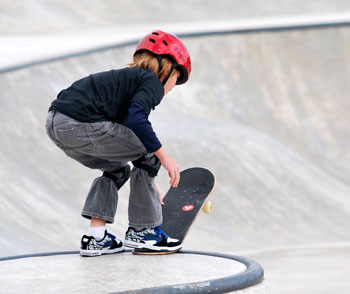
Ready to launch from the lip of the Riley Skatepark in Farmington Hills, Michigan. (Photo by the writer)
Last Saturday, the Ann Arbor Skatepark Action Committee loaded up the french-fry-oil fueled BTB Party Bus with as many local decision-makers as it could find and steered a course for Farmington Hills.
They wanted to show city councilmembers, park advisory commissioners and staff planners first hand what a free concrete skatepark looked like.
The field trip itself was meant in part as fuel for the imagination as the committee rolls towards an Oct. 18 skatepark design workshop, which starts at 2 p.m. at Slauson Middle School, located at 1019 W. Washington. It’s free and open to the public.
The planned location for the park is the northeast corner of Veterans Memorial Park at the intersection of Maple Road and Dexter Avenue, on Ann Arbor’s west side.
Almost a year ago, at its Dec. 1, 2008 meeting, the Ann Arbor city council passed a memorandum of intent to develop a skatepark at the Veterans Park location. Now the question facing skatepark supporters is: Where’s the money for building and maintaining the skatepark going to come from?
Private Funding
From its inception, skatepark supporters have emphasized their intent to raise as much of that money as possible through private donations. What they’ve asked of the city of Ann Arbor has been allocation of space in an existing park. And that’s been achieved.
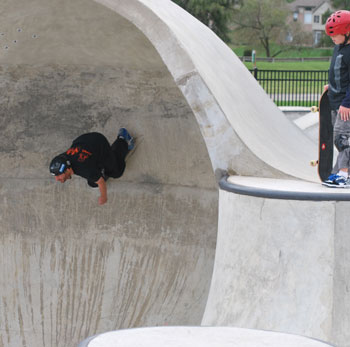
Trevor Staples skating the capsule at Riley Skatepark in Farmington Hills, Michigan. (Photo by the writer)
It’s what Mike Anglin (Ward 5) referred to as an “in kind” contribution from the city, when he gave his fellow councilmembers an update on the skatepark at the council’s Oct. 5 meeting. Anglin also reported at that meeting that the fundraising effort to date had accumulated around $17,000. There’s a lot of air yet between $17,000 and the $1 million that the supporters think it might take to design and build a 30,000-square-foot skatepark.
The gap between private donations to date and the amount of capital it will take to build and operate the park is one reason Carsten Hohnke (Ward 5) stressed the Oct. 18 design workshop in his own communications at the council’s Oct. 5 meeting. [The planned skatepark location is in Ward 5.]
Some kind conceptual design that people can look at will be key to ramping up the effort for private donations.
According to Trevor Staples of the Skatepark Action Committee, there was a glitch on the first try, but they are currently re-filing the paperwork for their official nonprofit status, which is expected to be finalized around the first of next year. That entity will be known as Friends of the Skatepark. Until then, donors can contribute in a tax-deductible way to the skatepark’s capital fund through the Ann Arbor Area Community Foundation, which is acting as the fiduciary for the effort.
Public Funding
What about public funding sources? The Chronicle followed up via Google Chat on that question with county commissioner Conan Smith – he’d originally planned to go along on the bus trip to Farmington Hills last Saturday, but circumstances conspired against that. Smith is actually quite sanguine about the possibility of a skatepark partnership between the county’s parks department, Washtenaw County Parks and Recreation Commission, and the city of Ann Arbor. Smith serves on WCPARC in one of the slots designated for members of the county board.
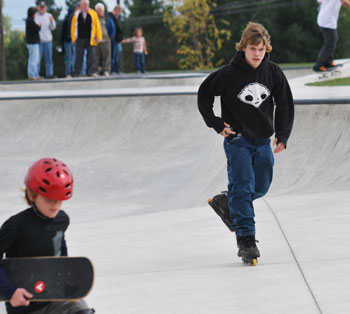
On his inline skates at Riley Skatepark in Farmington Hills is Rodney Snider. The 15-year-old Snider has skated the park "every single day since the beginning of summer." The Ann Arbor party bus contingent is standing in the distant background. (Photo by the writer.)
In speaking with both Smith and Bob Tetens, who’s director of Washtenaw County Parks and Recreation, a point they emphasized is that the maintenance and operation of the county’s parks are not paid for out of the county’s general fund. Instead, there are two dedicated millages at 0.25 mill apiece, levied countywide to pay for parks. One of the millages goes to capital improvements and development, and the other goes to operations.
Although there’s strong support on WCPARC for a skatepark, Tetens said, it’s not yet a part of their 5-10 year capital plan. At this point, Tetens explained, “We don’t have the numbers … We don’t know what ‘it’ is – a $200,000 park or a $2 million park.” Once you have a conceptual design, he said, you have a project you can talk about.
Smith, for his part, felt that a partnership between the county parks department and the city of Ann Arbor on the skatepark would expect the city to do more than make the land contribution. Cash or cash equivalents are what he’d be looking for. By cash equivalents, Smith meant cost savings though the contribution of professional design and engineering for the project by city staff.
On Location at Riley Skatepark in Farmington Hills
Riley Skatepark, the destination of the Oct. 3 party bus, is similar in size to the kind of skatepark that’s being planned for Ann Arbor. The concrete of Riley covers 29,000 square feet – the Ann Arbor Skatepark Action Committee generally talks about a 30,000-square-foot facility.
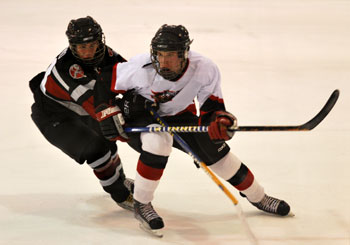
A hockey tournament was in full swing at the ice area in Founders Park on Oct. 3. (Photo by the writer)
It also has a similar context, located within a much larger sports park complex, Founders Park, which includes ball fields and an ice arena, as does Veterans Memorial Park in Ann Arbor.
The Chronicle traveled separately from the party bus and had some time to kill waiting for the Ann Arbor contingent to arrive.
On the opposite side of the Founders Park parking lot, with signs forbidding skateboarding in the lot, the ice arena looked warmer than the rain-soaked and wind-swept concrete of the skate park. A quick impression of under-16 hockey culture that we soaked up in an hour at the ice area: Hockey is mostly about gigantic dufflebags full of gear lugged by young men in matching windbreakers and pants, wearing shirts and ties.
We met up with the Ann Arbor bus contingent when Chris Cassell, who’s a member of Ann Arbor’s skatepark steering committee, greeted us. We’d been looking for folks to arrive in the unmistakable red BTB party bus, so we didn’t even recognize Cassell at first.
When the bus rolled up, among the folks it disgorged were Mike Anglin (Ward 5 city council representative), John Lawter (Ann Arbor Park Advisory Commission), John Barrie (executive director of the Appropriate Technology Collective and editor of www.SustainableDesignUpdate.com) and Amy Kuras (Ann Arbor city park planner), as well as Jim Reische and Trevor Staples, who are on the steering committee for the Ann Arbor skatepark.
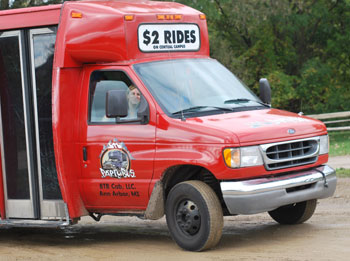
Big Ten Burrito Party bus arriving at Riley Skatepark. Visible in the passenger seat is Jordan Miller, former reporter for the Ann Arbor News, now blogger for AnnArbor.com and in charge of publicity for the skatepark action committee. (Photo by the writer)
Standing on the lip of the bowl, staring at all the blank concrete, a little impromptu design discussion unfolded among the Ann Arbor contingent. Kuras wanted to know if it might be possible to embed colors and graphics into the concrete.
Trevor Staples gave skateparks in Denver and Santa Cruz as examples where color had been used. Barrie suggested that an acid etching technique could be used on concrete to get color effects.
Looking at the capsule overhand, Barrie also mused that it could be easily built in the kind of slope that’s offered in the Veterans Memorial Park location in Ann Arbor.
Final Notes on the Field Trip
Staples and Cassell took advantage of the opportunity to actually skate at the park – Cassell drove separately so that he could stay and skate longer if he wanted. He wanted. Mike Anglin (Ward 5) had announced at the Oct. 5 council meeting that he had stood astride a board – but only on the grass. With the aid of some Chronicle magic, maybe readers will forget he said that: [Anglin getting some sweet air.]
The bus back home was piloted by Todd Eschenburg, who drives for the BTB Party Bus. He explained that the engine gets warmed up on diesel fuel, but that once it’s up to temperature, it switches over to the used fry oil that the bus is famous for. It’s the same procedure in reverse for turning off the engine – which explained why he was idling for a few minutes after arrival in the parking lot.




I’m glad they’re doing something like this. I remember being a kid in Ann Arbor and being arrested (!) for skateboarding, and the only alternative was a giant, dangerous, horribly constructed vert ramp (halfpipe) at Vets. Problem was, vert skating was long dead, and kids wanted something like what is being proposed now.
It’s really a shame that Ann Arbor took so long to get this stuff figured out, but now is better than never.
Was that Anglin shot shopped?
Re: [2] “Was that Anglin shot [Photo]shopped?” Yes. We had meant to cover that with “Chronicle magic.”
Campaign photo perhaps!!? Love it!
I have decided that ArborWiki does not care about editorial integrity: link to Anglin’s entry on ArborWiki.
@Matt, yes… but the pic you added looks so good.
(I should add — I was the one who added the pic)